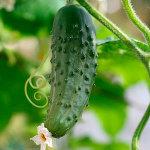Cucumber, Muskmelon, and Watermelon
Cucumbers, muskmelons and watermelons have similar cultural requirements. They are warm season vegetables and will not tolerate frost or soil temperatures below 55°F. Early and total yields are increased with plastic mulch. Either black or clear plastic may be used; but with clear plastic, a preemergence herbicide is necessary. On farms with several small fields, it is usually easier to use black plastic than to have the inconvenience of herbicide applications with clear plastic. Before the plastic is laid, be sure the soil is fertilized and fitted to a smooth surface. The plastic should fit snugly against the surface. Do not lay plastic on dry soil; either irrigate or wait for rain.
In conjunction with plastic mulching, plastic with hoops and spunbonded row covers will provide earlier and higher yields. Apply the covers at the time of planting and leave on until the time for pollination by bees (bloom). These crops can withstand high temperatures under the covers.
Soils that warm up fast in the spring are preferred to heavier soils that remain cool. Muskmelon should be grown on very well-drained soil for optimum quality. Raised beds provide additional benefits. The soil should be fertile and high in organic matter. On sandy soils, irrigation is necessary.
Cucumbers may be direct seeded or started as transplants. The latter method is preferred for early crops. Because of the long season required for muskmelon and watermelon, transplants are used. The plants should be about three weeks old, with one to two true leaves at transplanting time. Older transplants that have begun to run are difficult to handle and suffer greater transplant shock. Peatlite mix in peat pots or peat pellets are excellent starting media. Keep pots or pellets thoroughly moist but not soaking wet.
In some growing seasons, vine crops that recently have been transplanted or recently have germinated, suddenly wilt and die. Most often, this situation occurs during a period of four to five days of rainy or cloudy weather. Without sunshine, soil temperatures drop below 55°F to 60°F. At these soil temperatures the plant roots cannot absorb water from the soil. Consequently, when the sun does reappear, water transpires from the leaves much more rapidly than the roots absorb water, resulting in sudden wilting and death. Basically, there is no control for this problem, except to attempt to manipulate planting around weather forecasts. Earlier planting dates increase susceptibility to this problem.
A sufficient number of pollinating insects should be present to insure adequate fruit set in cucumber and melons. One strong hive of honeybees per acre as flowers just begin to open is recommended.
For Current information on production methods (including varieties, spacing, seeding, and fertility), weed, disease, and insect management, please visit the New England Vegetable Management Guide website
Major disease problems in this crop:
- Cucumber Mosaic Virus
- Cucurbits, Alternaria Leaf Spot
- Cucurbits, Anthracnose
- Cucurbits, Bacterial Wilt
- Cucurbits, Black Rot
- Cucurbits, Downy Mildew
- Cucurbits, Fusarium Fruit Rot
- Cucurbits, Plectosporium Blight
- Cucurbits, Powdery Mildew
- Cucurbits, Scab
- Cucurbits, Zucchini Yellow Mosaic Virus
- Phytophthora Blight
- Pythium Fruit Rot
- Tomato Spotted Wilt Virus
- White Mold
Major insect pests that affect this crop:
The Center for Agriculture, Food and the Environment and UMass Extension are equal opportunity providers and employers, United States Department of Agriculture cooperating. Contact your local Extension office for information on disability accommodations. Contact the State Center Director’s Office if you have concerns related to discrimination, 413-545-4800 or see ag.umass.edu/civil-rights-information.
